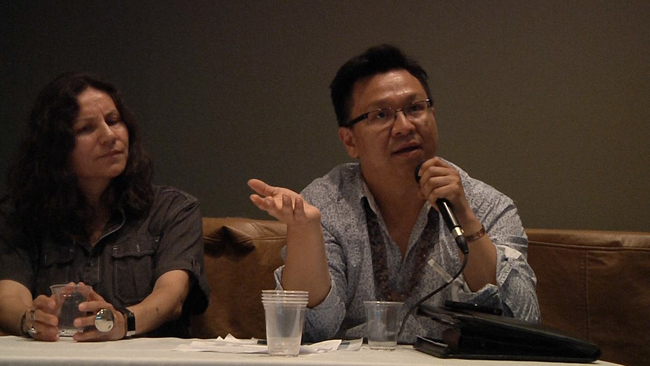Exhibit explores tangled relationships

By Shirley Honyust
LONDON, Ont. – For Dolleen Manning, a major difference between Indigenous artists and others is their sense of being connected to other elements of Creation – for them, the self is relational, not solitary.
The “complex challenges, disparate interests, and paradoxical relationships” that they experience in encountering what she calls “Western realities” was the theme behind a show she curated at Forest City Gallery called Gashka’oode, an Ojibwe term referring to relational entanglements.
“In this project,’ she says, “ I ask how contemporary Indigenous artists respond to the encounter with Western realities, in and through their understandings of a self that is always already constructed in relation to difference.”
Manning, a citizen of Ashoodona — Stoney Point First Nation, controversially absorbed by the federal government into Kettle and Stony Point First Nation – is an artist and independent curator whose work focuses on encounters between critical theory, Anishinaabe philosophy and visual culture. This was the driving force behind the Gashka’ oode exhibit and forms the basis of her doctoral research at the Centre for the Study of Theory and Criticism at Western University. Manning is a recipient of the prestigious Vanier Canada Graduate Scholarship, has an M.A. in Theory and Criticism from Western University, a Master of Fine Arts in Contemporary Arts from Simon Fraser University, and a B.F.A. from the University of Windsor.
“As curator, I am interested in the “entanglements” reflected in the heterogeneity of Aboriginal experiences” she says. “Thus I selected these artists more for their differences than their similarities. Confronted with the complex challenges, disparate interests and paradoxical relationships posed by contemporary Indigenous experiences, the artists refuse to latch on to easy answers and complacent stereotypes.”
The artists in Gashka’oode are extremely diverse, not only in their relationships to Indigenous cultures and communities, but also in their mediums that include digital media, sculpture, photography and performance. Their works share themes of entanglement in which subjects negotiate being in-relation and out-of-place.
Cree/Metis visual artist Jason Baerg combines painting and multimedia to create conceptual works about urban Aboriginal subjectivity. Wally Dion — a Saulteaux from Yellow Quill First Nation — used computer circuit board star blankets to create Shield Wall.
Before the launch of Gashka’ oode, a panel discussion at Museum London brought together Indigenous arts and cultural practitioners to discuss the tangled relationship between traditional and contemporary Indigenous values and philosophical approaches in their professional, artistic and everyday realities.
Participants included Luke Nicholas, N`Amerind Friendship Centre president; Greg Hill, the National Gallery of Canada’s curator of Indigenous Art; Mona Stonefish, Anishinaabe Elder and Cultural Advisor; and playwright Candace Brunette.
Afterwards, audience members were transported to the Forest City Gallery to see the exhibits, meet the artists and partake in a feast of Indigenous food fare, prepared and delivered by a group of community volunteers.


